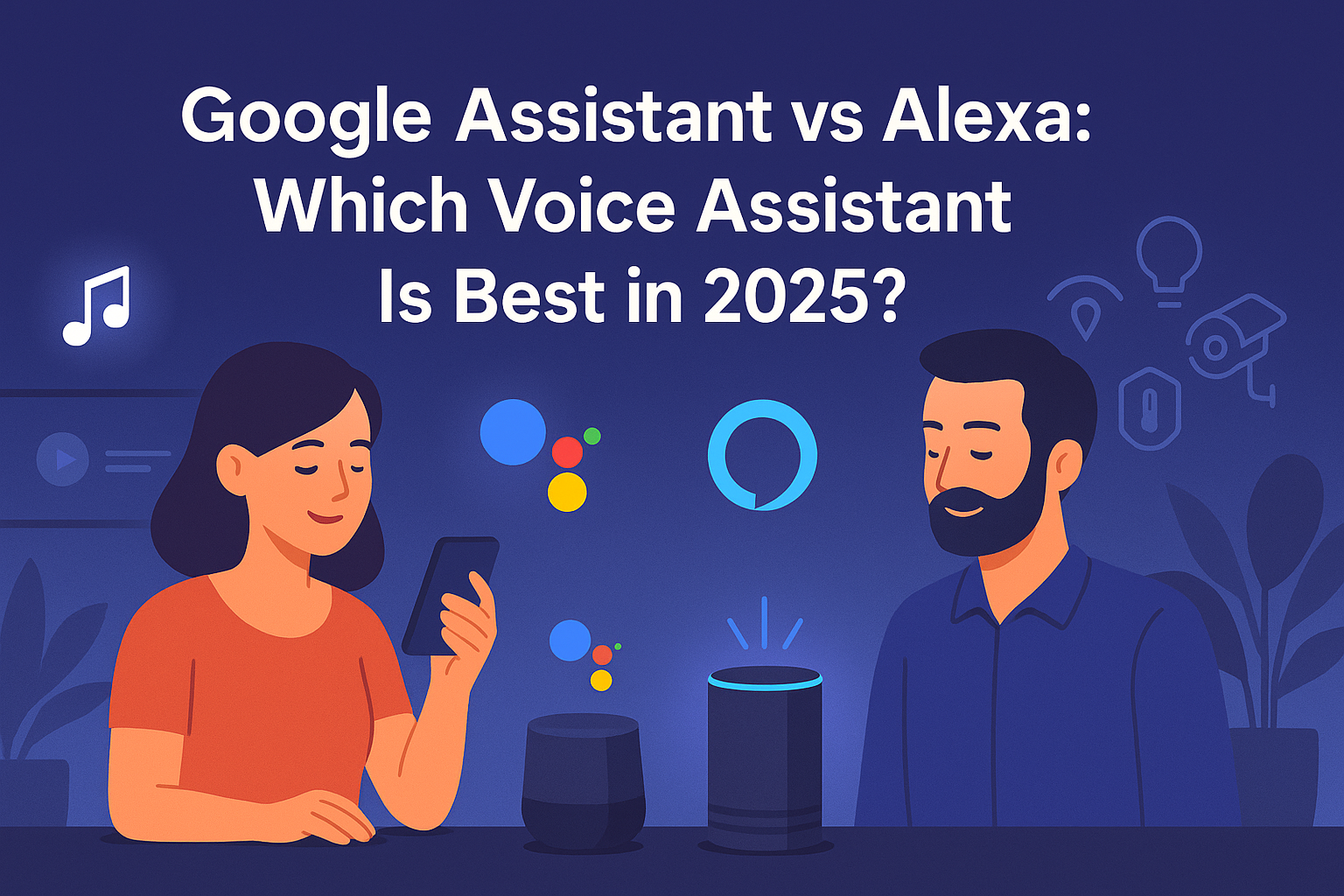In the age of smart homes and digital convenience, voice assistants have become household essentials. From setting reminders and controlling lights to answering questions and managing entire home ecosystems, these AI-powered tools are transforming how we interact with technology. Two giants continue to dominate the space: Google Assistant and Amazon Alexa.
But in 2025, with both platforms having evolved significantly, which one truly stands out? If you’re trying to decide which voice assistant best suits your needs, this guide will walk you through the key differences, strengths, and ideal use cases for each.
Google Assistant in 2025: Smarter and More Context-Aware
In 2025, Google Assistant continues to evolve as one of the most powerful and intelligent voice assistants on the market. What sets it apart is its deep integration with Google’s ecosystem and its impressive ability to understand context, anticipate user needs, and deliver highly personalized help.
Smarter Context Recognition
One of the biggest improvements in 2025 is Google Assistant’s advanced context awareness. Instead of simply reacting to basic voice commands, it can now interpret complex queries based on your current location, activity, and even prior interactions. For example, if you say “Remind me to buy groceries,” Google Assistant knows to send the alert when you’re near your favorite supermarket—not just at a preset time.
Thanks to on-device processing and AI advancements, Google Assistant can handle multi-turn conversations more naturally. You can ask, “What’s the weather today?” followed by “What about tomorrow in Paris?” and it will correctly understand that you’re asking about a different location for the forecast—without needing to repeat yourself.
Seamless Integration with Google Services
Google Assistant shines when used within the broader Google ecosystem. It works flawlessly with Gmail, Google Calendar, YouTube, Maps, Google Photos, and more. You can easily ask things like:
- “What’s on my schedule this afternoon?”
- “Send an email to Sarah confirming the meeting.”
- “Show me photos from my last trip to Italy.”
It also syncs well with Android devices, smart displays, and Google Nest products, allowing you to control smart lights, thermostats, and doorbells with just your voice.
Improved Personalization
Google Assistant is getting better at understanding your preferences over time. It adapts to your routines, suggests actions based on habits (like turning off the lights when you go to bed), and tailors content—like news briefings, commute times, or restaurant recommendations—based on your interests and past behavior.
With the addition of voice matching, the Assistant can distinguish between different users in the same household, providing personalized responses for everyone. Whether it’s playing your favorite playlist or reading out your calendar events, the experience feels tailored and individualized.
Enhanced Multilingual Capabilities
Google Assistant now supports seamless multilingual interactions. You can speak to it in multiple languages, and it will respond appropriately without needing to switch settings. This is especially useful in multicultural homes or for users who speak more than one language daily.
Smart Home Leadership
In terms of smart home control, Google Assistant continues to lead the pack. It supports thousands of devices across hundreds of brands and works with Matter and Thread protocols for better cross-platform compatibility. Setting up routines like “Good Morning” or “Movie Night” is now easier than ever—and can include everything from adjusting the thermostat and dimming the lights to playing a specific Spotify playlist.
In summary, in 2025 Google Assistant is more intuitive, proactive, and deeply integrated into daily life than ever before. Its unmatched understanding of context, smooth coordination with Google services, and growing smart home compatibility make it a top choice for users who value efficiency, personalization, and seamless connectivity.
Amazon Alexa in 2025: The Smart Home Powerhouse
In 2025, Amazon Alexa has cemented its position as the go-to voice assistant for smart home enthusiasts. With continued investment in device compatibility, user customization, and AI-driven features, Alexa is now more powerful, responsive, and user-friendly than ever before. For many homeowners, Alexa isn’t just a voice assistant—it’s the central brain of their connected household.
Unmatched Smart Home Integration
Alexa’s biggest strength remains its unmatched smart home compatibility. As of 2025, Alexa supports over 140,000 smart home devices from thousands of brands, ranging from lights and thermostats to door locks, garage doors, kitchen appliances, and robot vacuums. Thanks to Amazon’s early and aggressive push in the IoT space, Alexa continues to offer the widest device support on the market.
Alexa is fully compatible with Matter, the new universal smart home standard, making it easier than ever to connect devices regardless of brand. Whether you’re using smart bulbs from Philips Hue, a thermostat from Ecobee, or a robot vacuum from iRobot, you can expect smooth performance and unified voice control.
Powerful Routines and Automations
Alexa’s routine-building tools have evolved significantly in 2025, giving users greater control over how their smart home behaves. You can now create highly detailed, multi-step routines triggered by:
- Voice commands (“Alexa, good morning”)
- Schedules (e.g., every weekday at 7:00 AM)
- Sensor inputs (motion detection, door open/closed, etc.)
- Location-based actions (when you arrive or leave home)
For example, a bedtime routine might turn off all the lights, lock the doors, lower the thermostat, and start a sleep playlist—all triggered by a simple voice command or motion sensor.
New in 2025 is Alexa Ambient Intelligence, which allows Alexa to proactively suggest or carry out helpful actions based on your patterns. If you normally turn off the porch light at 10 p.m., Alexa can offer to automate that for you—or just start doing it without you needing to ask.
Alexa Skills: Endless Customization
Another standout feature is Alexa’s library of Skills—mini apps created by third-party developers. With over 100,000 Skills available, users can enhance their experience with:
- Guided workouts and fitness challenges
- Meditation and wellness routines
- Interactive storytelling and trivia games
- Smart home tools, like routines that tie into security systems or kitchen appliances
In 2025, Skills have become more conversational and AI-powered, meaning more natural dialogue and better responses across entertainment, productivity, and daily tasks.
Enhanced Voice and Visual Experience
With the latest Echo Show devices, Alexa offers both voice and visual interfaces. The built-in displays can show security camera feeds, to-do lists, weather reports, video calls, and more. Combined with Drop In and Alexa Calling, the assistant doubles as a smart intercom and communication hub for families.
Alexa’s voice has also become more expressive and human-like. Users can now choose from a range of voices and personalities—including celebrity voices—and benefit from improved emotional tone recognition, making conversations more natural and nuanced.
Privacy and Customization
Amazon has made strides in privacy controls. In 2025, users can:
- Mute Alexa at any time with a physical button
- Automatically delete voice recordings every day, week, or month
- Review and manage all interactions through the Alexa app
You can also customize Alexa’s wake word (not just “Alexa”) and its response style, helping create a more personal and comfortable experience.
Ideal for Families and Smart Homes
Alexa is especially well-suited for families:
- Parental controls and kid-friendly content make it safe for children.
- Household profiles ensure personalized responses based on the user speaking.
- Announcements and intercom features make it easy to communicate across rooms.
In homes with multiple smart devices, Alexa acts as a seamless control center that just works—reliably and intuitively.
In summary, Amazon Alexa in 2025 is more than just a voice assistant—it’s a full-featured smart home hub, daily planner, and digital concierge. If your priority is automating your home, connecting a wide range of devices, and enjoying voice-first convenience, Alexa remains a powerhouse that delivers reliability, flexibility, and endless potential.
Google Assistant vs Alexa: Feature Comparison
| Feature | Google Assistant | Amazon Alexa |
| Smart Home Integration | Excellent (growing fast) | Outstanding (largest ecosystem) |
| Natural Language Understanding | Superior | Very good |
| Media & Entertainment | Great with YouTube, Spotify | Great with Amazon Music, Spotify |
| Routine Automation | Basic to Advanced | Advanced with smart suggestions |
| Ecosystem Integration | Google services & Android | Amazon shopping & Alexa Skills |
| Smart Display Support | Excellent (Nest Hub, Android TV) | Strong (Echo Show series) |
| Mobile App Experience | Clean and intuitive | Robust but more complex |
Conclusion: Alexa or Google—What’s Right for You
In the end, the best voice assistant for you in 2025 depends on what matters most in your digital lifestyle. Google Assistant excels at natural interactions, proactive help, and tight integration with the Android and Google ecosystem. It’s the perfect companion for productivity, search, and everyday efficiency.
Amazon Alexa, on the other hand, is still the go-to for smart home enthusiasts who value powerful automation, broad device compatibility, and convenience through voice-controlled routines. If you want your home to respond intelligently to your habits and needs, Alexa delivers that experience with precision.
Both assistants have matured into reliable, intelligent tools that go beyond answering questions—they help you streamline daily tasks, enhance comfort, and stay in control of your world. Whether you say “Hey Google” or “Alexa,” you’re choosing a future where your voice shapes the way you live.




